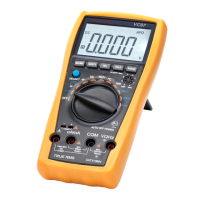3. Be careful when measuring high voltage.
4-3. ACV measurement
1. Insert the black lead to “COM” socket and the red one to “ VΩHz” socket.
2. Set the function switch to “V” range, press DC/AC key to select AC measuring
mode
3.the default states is auto range, display”AUTO” symbol,press “range” key to
select manual range , you can choose 400mV、4V、40V、400V、750V range.
4.connect the test leads to the test point ,voltage and polarity of the point which
connect with red test leads will be display on LCD.
NOTE:
1. the 400mV range only has the manual range,if you need to use 400mV
range,press “RANGE” key to select this range.
2.If “OL” displays, it means over-range, should set the range knob to a higher
range.
3.The tested voltage can not be over 750V AC; when changing function and
range, the leads must be away from the testing point.
4.Be careful when measuring high voltage.
4-4. DCA measurement
1 Insert the black lead to “COM” socket and the red one to “mA” or “20A” socket.
2 Set the function switch to “A” range, press DC/AC key to select DC working
mode,connect the test leads across to the circuit under tested, the current value and
polarity of the point which red lead connect will display on LCD.
NOTE:
1.If the measured current is unsure beforehand, should set the range knob to a
higher range, then, switch to a proper range according to the displayed value.
2.If “OL” displays, it means over-range, should set the range knob to a higher
range.
3.When tested current ≥10A under 20A range ,buzzer will be sound.
4.Max. input current is 400mA or 20A(subject to where red lead insert), excessive
current will blow the fuse. Be careful when measuring 20A due to un-fused.
Continuously measuring large current may heat the circuit, affect the accuracy,
even damage the meter.
4-5. ACA measurement
1 Insert the black lead to “COM” socket and the red one to “mA” or “20A” socket.
2.Set the function switch to “A” range, press DC/AC key to select AC working
mode ,connect the test leads across to the circuit under tested, the current value and
polarity of the point which red lead connect will display on LCD.
1.If the measured current is unsure beforehand, should set the range knob to a higher range,
then, switch to a proper range according to the displayed value.
2.If “OL” displays, it means over-range, should set the range knob to a higher range.
3.When tested current ≥10A under 20A range ,buzzer will be sound.
4.Max. input current is 400mA or 20A(subject to where red lead insert), excessive current
will blow the fuse. Be careful when measuring 20A due to un-fused. Continuously
measuring large current may heat the circuit, affect the accuracy, even damage the
meter.
4-6. Resistance measurement
1. Insert the black lead to “COM” socket and the red one to “ VΩHz” socket.
2. Set the function switch to “Ω” range, if the resistance under measured f unknown,
should set to a higher range.
3.press “Range ” key to select auto range or manual range mode.
4.if measuring the small resistance, should short-circuit at first, press “REL” key,and then
measuring the unknown resistane, it actual resistance will be display on the LCD,
NOTE:
1. If the measured resistance is unsure beforehand, should set the range knob to a
higher range, then, switch to a proper range according to the displayed value.
2. If “OL” displays, it means over-range, the range knob should be set to a higher
range.When the resistance is over 1MΩ, the reading should take a few seconds to be
stable. It is normal at high resistance measurement.
3.When input terminal is open circuit, “OL” displays.
4.When measuring in-line resistance, be sure the power has been turned off
and all capacitors are fully released.
5.Do not input voltage at this range.
4-7. Capacitance measurement
1 Set the function switch to “ ” range
2. Insert the black lead to “COM” socket and the red one to “ VΩHz”
socket.
3.if the LCD isn’t display zero ,press “REL” key to clear zero.
4. Insert the capacitor to “Cx” socket according to the polarity, the value will
display on LCD.
NOTE:
1. Don’t input voltage and current signal in the “VΩHz” jack when
measuring the capacitor.
2. Be sure to press “REL” to clear zero before measuring.
3. Capacitance range only have auto range working mode.
4. Release the capacitors completely to avoid damaging the meter
5. 200uF range input reading steady large than 15 Sec,.
6. Unit: 1uF=1000nF 1nF=1000pF
4-8. Frequency measurement
1. Insert the black leads to “COM” socket and the red one to “VΩHz”
socket.
2. Set the range switch to “Hz” range.
3 The range is auto-range. Connect the leads across to the signal under
measured, the value will be displayed on LCD.
NOTE:
1. There is only auto-range at this range.
2. When input is over 10V Ac rms, reading is possible, but maybe
over-range.
3. It’s better to use shield cable when measuring small signals in noisy
place.
4. Be careful when measuring high voltage.
5. Do not input voltage over 250V DC/AC peak value.
4-9. hFE measurement
1. Set the function switch to hFE range.

